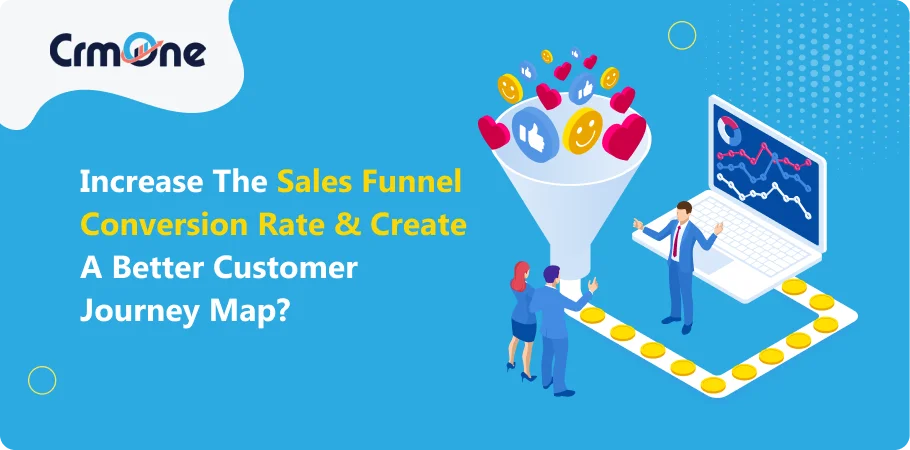Increasing the sales funnel conversion rate and creating a better customer journey map are essential for driving revenue growth and maximizing the efficiency of your marketing efforts. To achieve higher sales funnel conversion rates, it’s important to optimize each stage of the sales funnel, from attracting more website visitors to converting free trial users into paying customers.
This involves a detailed conversion funnel analysis, using a funnel analysis tool to gather all the data necessary for making data-driven decisions. By examining the sales funnel metrics and identifying key conversion events, you can pinpoint where prospects drop off and make adjustments to improve the funnel conversion rate.
Focusing on conversion rate optimization at every stage, including the landing page, helps in converting visitors to repeat customers. Understanding the customer’s journey through funnel stages and utilizing sales funnel metrics allows for a comprehensive view of the entire sales funnel. This enables you to improve the sales conversion rate and drive total revenue.
What is sales funnel conversion rate?
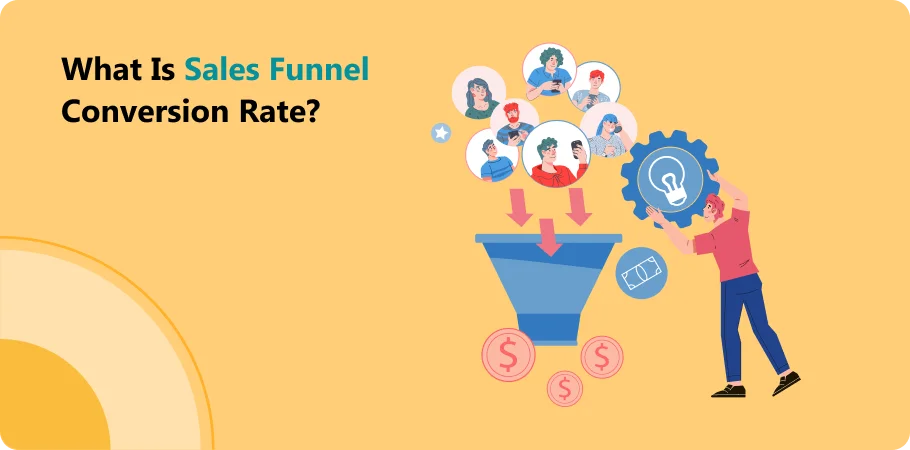
The sales funnel conversion rate is a key metric in marketing and sales efforts. It measures the percentage of website visitors, leads, or potential customers who progress through the various stages of your sales funnel and ultimately convert into paying customers.
In simpler terms, imagine your sales funnel as a pathway that leads visitors towards a desired action, typically a purchase. The conversion rate indicates how effective your marketing funnel or conversion funnel is at guiding visitors through this pathway.
Here’s a breakdown of the key terms involved:
Sales Funnel: This is the journey a potential customer takes from initial awareness of your product or service to the final purchase decision. It’s typically visualized as a funnel shape because a larger number of people enter the funnel at the top (awareness stage), and a smaller, more qualified group reaches the bottom (conversion stage).
Conversion Rate: This is a broader term used in marketing that refers to the percentage of visitors who take a desired action, not just necessarily a purchase. It can be applied to various stages of the funnel, such as converting website visitors into leads or converting leads into paying customers.
Sales Funnel Conversion Rates: When we specifically discuss conversion rates within the sales funnel context, we’re focusing on the percentage of leads or potential customers who move from one stage of the funnel to the next, ultimately reaching the final conversion (purchase).
By analyzing your sales funnel conversion rates at different stages, you can gain valuable insights into the effectiveness of your marketing and sales efforts. It helps you identify areas for improvement and optimize your funnel to maximize conversions.
steps that customers take before making a purchase

Customer Journey Through the Sales Funnel
The customer journey, visualized as a sales funnel, represents the path potential customers (your target audience) take before becoming paying customers. Each stage contributes to the overall sales funnel conversion rate, a key metric for your sales team.
Here’s a breakdown of the typical steps:
Awareness: At this initial stage, potential customers become aware of your product or service, often through marketing efforts. This could involve social media campaigns, search engine optimization (SEO) that drives organic website traffic, or content marketing that educates them about their problem and potential solutions.
Interest: Once aware, customers who find your offering relevant might delve deeper. They may visit your website, download informative content (e.g., white papers, ebooks), or engage with your social media content. The goal here is to capture their interest and nurture them as leads.
Consideration: Now interested, potential customers compare your product or service with competitors. They might research online reviews, compare features, or even request demos or consultations. This stage requires compelling product information, clear value propositions, and addressing common concerns to move them further down the funnel.
Decision: At this point, customers are ready to make a purchase decision. Highlighting testimonials, showcasing case studies, and offering free trials or consultations can be instrumental in influencing their choice and maximizing your funnel conversion rate.
Purchase: Congratulations! The customer has converted into a paying customer. However, the journey doesn’t end here.
Beyond the Purchase
Providing excellent customer service, loyalty programs, and valuable post-purchase content can encourage repeat business and positive word-of-mouth recommendations, further boosting your sales funnel conversion rates in the long run.
By understanding these stages and analyzing your sales funnel metrics at each point, you can identify areas for improvement and optimize your marketing and sales efforts to guide more potential customers towards a purchase.
How can I track where potential customers abandon my sales process?
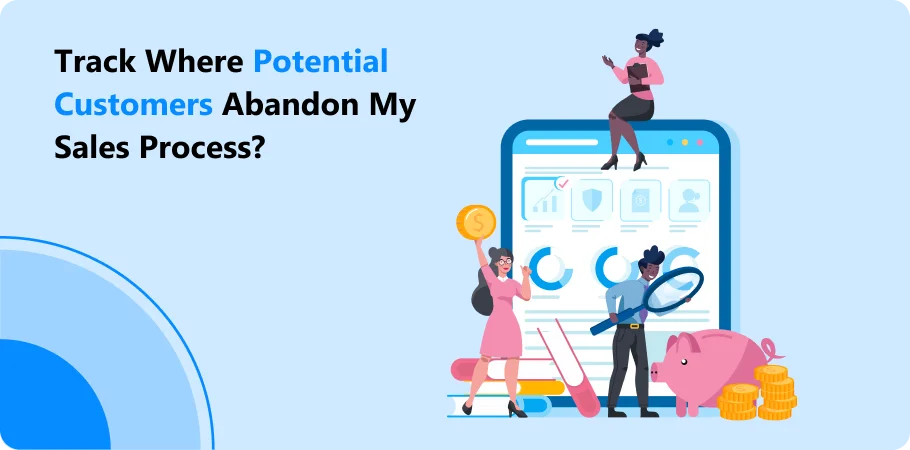
Identifying Drop-Off Points in Your Sales Funnel
Tracking where potential customers abandon your sales process, also known as your marketing funnel, conversion funnel, or sales cycle, is crucial for optimizing conversion rates and maximizing average revenue. Analyzing your sales funnel metrics at each stage allows you to identify areas for improvement and implement strategies to keep your target audience engaged throughout the journey.
Here are some effective methods to pinpoint drop-off points:
Website Analytics: Utilize website analytics tools like Google Analytics to track user behavior. These tools can reveal which pages visitors leave from, how long they spend on specific pages, and where they enter and exit your sales funnel. Analyzing this data helps you identify stages with high exit rates, indicating potential drop-off points.
Form Abandonment Tracking: Monitor how many potential customers abandon online forms during the sales process. This could be a signup form, a quote request form, or a purchase form. By analyzing which fields are causing abandonment, you can simplify forms, improve user experience, and potentially increase conversion rates.
CRM Data Analysis: If you utilize a Customer Relationship Management (CRM) system, leverage its data to track customer interactions with your sales team. Analyze missed calls, unanswered emails, or lack of follow-up at specific stages to identify potential bottlenecks or drop-off points within your sales cycle.
Heatmaps and Session Recordings: Tools like heatmaps and session recordings can visually show how visitors interact with your website. Heatmaps indicate where users click and scroll, while session recordings capture their entire website journey. This data can reveal confusing layouts, unclear calls to action (CTAs), or navigation issues that lead to drop-off.
Customer Feedback: Don’t underestimate the power of direct customer feedback. Conduct surveys or exit-intent popups to understand why potential customers might be abandoning your sales process. Their insights can reveal pain points, missing information, or confusing steps that need addressing.
By implementing these techniques for funnel conversion analysis, you can gain valuable insights into your sales funnel model. This allows you to focus on conversion funnel optimization and conversion rate optimization strategies. Remember, a well-optimized funnel should guide your target audience seamlessly towards becoming paying customers.
What are some simple ways to improve website navigation and user experience?
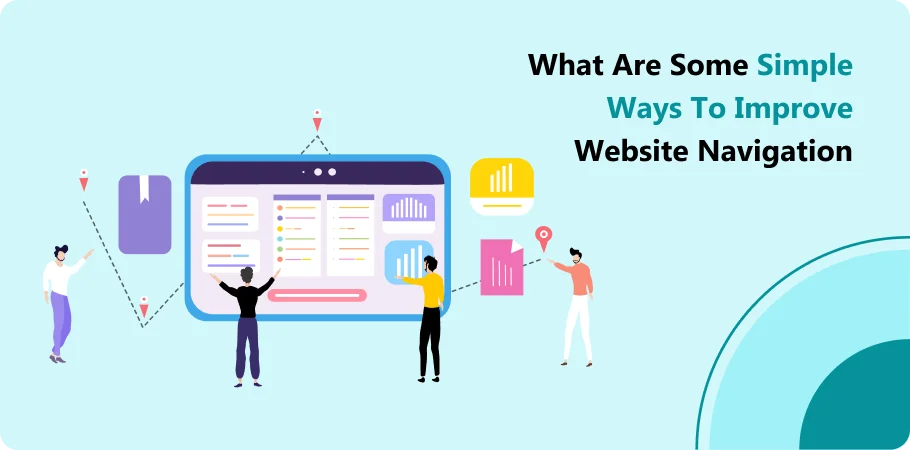
Optimizing website navigation and user experience (UX) directly impacts your sales funnels (plural) and conversion rates. A well-designed website guides potential customers through their customer journey seamlessly, ultimately resulting in conversions and potentially boosting average revenue generated.
Here are some practical tips to consider:
Clear and Intuitive Navigation: Make sure your website navigation is clear, concise, and easy to understand. Users should be able to find the information they seek within a few clicks.
Search Functionality: Implement a user-friendly search bar to allow visitors to quickly locate specific information or products.
Mobile-Responsive Design: In today’s digital world, a responsive website design that adapts seamlessly to mobile devices is crucial. This caters to a wider audience and potentially increases website traffic.
Fast Loading Speed: Slow loading times can significantly impact user experience and lead to visitors abandoning your site. Optimize your website for speed to keep users engaged.
Compelling Landing Pages: Create targeted landing pages with clear calls to action (CTAs) that guide potential customers towards specific conversion points within your sales funnel stages. Customer testimonials can be powerful additions to landing pages, building trust and credibility.
Enhancing User Experience with Content and Trust
Beyond navigation, user experience is also influenced by the content you present and the trust signals you convey:
High-Quality Content: Provide informative and valuable content that addresses your target audience’s needs and interests. This could include blog posts, white papers, case studies, or product descriptions.
Clear Contact Information: Make it easy for visitors to reach you by displaying clear contact information, including phone numbers, email addresses, and live chat options if available.
How can I tailor my marketing messages to resonate with potential customers at various stages of the funnel?

An effective conversion funnel guides potential customers through a well-defined customer journey. To maximize the impact of your marketing efforts and encourage repeat purchases, it’s crucial to tailor your marketing messages to resonate with each stage of the funnel.
Here’s a breakdown of how to customize your approach:
Awareness Stage (Initial Spark):
- Focus: Spark initial awareness of your brand and product or service.
- Messaging: PEmphasize broad pain points or needs your target audience might face.
- Examples: Broad awareness campaigns on social media or paid marketing channels can highlight common industry challenges your product solves.
Interest Stage (Deeper Engagement):
- Focus: Capture their interest and nurture leads.
- Messaging: Provide educational content that addresses their specific needs and interests. Offer valuable resources like blog posts, white papers, or infographics.
- Examples: Targeted email marketing campaigns with informative content related to their pain points.
Book a CrmOne Demo
Experience the CrmOne simplicity and power. Our experts will show you the best ways to use it and answer your questions in real time. See how CRMOne fits your needs.
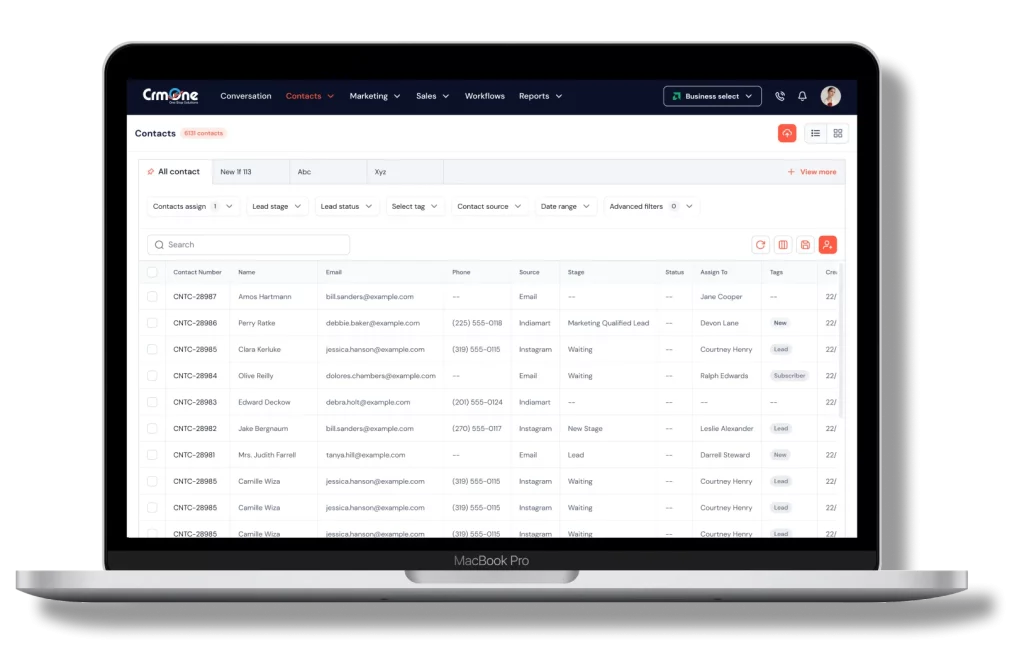
Consideration Stage (Making Comparisons):
- Focus: Position yourself as the preferred solution.
- Messaging: Highlight your product’s unique value proposition and competitive advantages. Showcase customer testimonials and case studies to build trust and credibility.
- Examples: Product comparisons, free trial offers for your service, or webinars showcasing your solution’s benefits.
Decision Stage (The Final Push):
- Focus: Address any remaining concerns and motivate a purchase decision.
- Messaging: Offer limited-time promotions, highlight guarantees, or showcase social proof like user reviews. Emphasize the benefits of becoming a customer.
- Examples: Targeted email campaigns with discount codes, free consultations, or clear calls to action (CTAs) encouraging purchase.
Leveraging Customer Journey Insights
By developing a customer journey map and analyzing funnel metrics like SQL conversion rate and customer retention rate, you gain valuable insights into your target audience’s behavior and preferences at each stage. This allows you to tailor your marketing strategy to deliver targeted messages that resonate with them, ultimately leading to a more effective conversion funnel and potentially increased total revenue generated.
What types of content can I create to nurture leads and build trust with potential buyers?

Content for Nurturing Leads and Building Trust
The type of content you create to nurture leads will vary greatly depending on your target audience and their stage in the buyer journey. Here are some effective options to consider:
Awareness Stage:
- Blog Posts: Publish informative blog posts that address broad industry challenges or topics relevant to your target audience’s initial awareness stage.
- Social Media Content: Share engaging and informative content on social media platforms to spark initial brand awareness and capture interest.
- Infographics: Create visually appealing infographics that condense complex information into easily digestible visuals, ideal for grabbing attention during the awareness stage.
Interest Stage:
- Ebooks and White Papers: Offer downloadable ebooks or white papers that delve deeper into specific topics of interest to your target audience during the interest stage.
- Case Studies: Showcase successful customer stories through case studies, demonstrating the value proposition of your product or service and building trust.
- Webinars: Host informative webinars led by industry experts to educate potential buyers and address their specific needs in the interest stage.
Consideration Stage:
- Product Comparisons: Create objective comparisons highlighting the advantages of your product or service against competitors.
- Free Trials or Demos: Offer free trials or product demos to allow potential buyers to experience your offering firsthand during the consideration stage.
- Customer Testimonials: Showcase positive customer testimonials and reviews on your website and marketing materials to build social proof and trust.
Nurturing Leads Through Email Marketing:
Email Campaigns: Develop targeted email campaigns that deliver valuable content tailored to each stage of the buyer journey.
Measuring Success:
Track important metrics such as email open rates, click-through rates, and website traffic to gauge the effectiveness of your content marketing efforts.
Building Trust Throughout the Journey:
By consistently delivering informative and valuable content at each stage of the buyer journey, you can nurture leads, address their concerns, and build trust with potential buyers. This ultimately leads to a more informed and confident customer base, fostering repeat customers and long-term success for your online store.
How can I leverage customer feedback to continually improve both the sales funnel and customer journey map?

Harnessing Customer Insights for Continuous Improvement
Customer feedback is a goldmine of valuable information that can be used to optimize your company’s conversion funnel and enhance the customer journey map. By actively soliciting and analyzing feedback, you can gain insights into potential customer pain points, identify areas for improvement, and ultimately boost sales conversion rates (without mentioning average conversion rate) and average order value.
Here are some effective methods to leverage customer feedback:
Gather Feedback Throughout the Customer Journey:
Customer Satisfaction Surveys: Implement surveys at various touchpoints throughout the customer journey, including post-purchase, to gauge satisfaction and identify areas for improvement.
Customer Support Interactions: Analyze customer support interactions to understand common challenges or frustrations potential customers encounter within the sales cycle length.
Social Media Monitoring: Monitor social media mentions to identify trends and sentiment surrounding your brand, product, or service. This can reveal potential issues or areas for improvement in the customer journey.
Analyze and Categorize Feedback:
Categorize Feedback: Organize the collected feedback by theme or topic to identify recurring issues or areas of praise.
Identify Trends: Analyze patterns within the feedback to pinpoint common pain points or areas for improvement.
Take Action Based on Insights:
Marketing Team Collaboration: Share customer feedback with your marketing team to inform targeted marketing campaigns that address customer needs and preferences.
Sales Funnel Optimization: Utilize feedback to identify bottlenecks or drop-off points within your sales funnel, and implement strategies to streamline the customer journey.
Product Development: If feedback reveals feature requests or product limitations, share these insights with your product development team to inform future iterations.
Continuously Evaluate and Refine:
Customer Journey Map Updates: Regularly update your customer journey map based on the feedback you gather. This ensures it reflects the current customer experience.
A/B Testing: Implement A/B testing on various elements of your website or marketing campaigns to see which approaches resonate best with potential customers, ultimately leading to a more effective conversion funnel.
By actively soliciting and analyzing customer feedback, you gain a deeper understanding of your target audience’s needs and expectations. This allows you to continuously refine your sales funnel and customer journey map, ultimately fostering a more positive customer experience, potentially increasing average order value, and driving long-term business growth.
What strategies can I implement to retain customers and encourage repeat business?
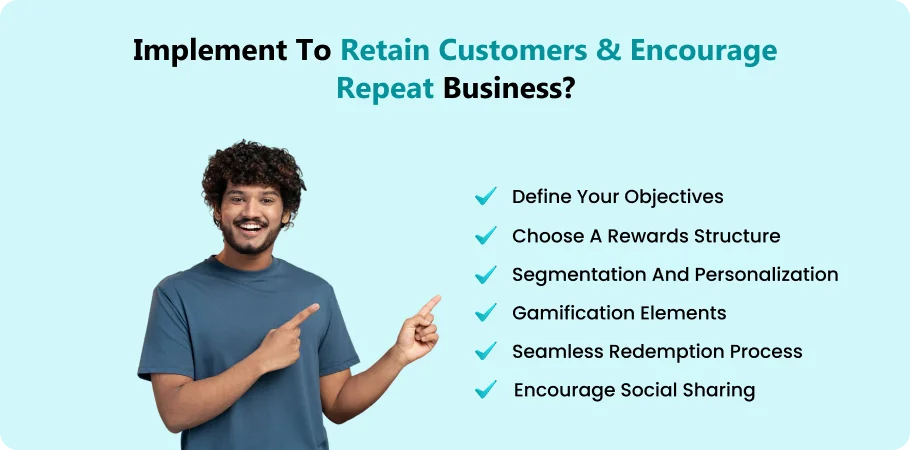
Retaining existing customers and fostering repeat business is crucial for sustainable growth. Here are some effective strategies to consider:
Focus on Customer Experience (CX):
Prioritize Customer Satisfaction: Make customer satisfaction a top priority throughout the entire buying process. Gather feedback through surveys or reviews to identify areas for improvement.
Streamline the Customer Journey: Analyze data to identify and address any friction points within the customer journey. This could involve simplifying the checkout process or providing clear instructions at each stage.
Implement a Customer Loyalty Program:
Reward Repeat Business: Design a loyalty program that rewards repeat customers for their continued patronage. This could involve offering points, discounts, or exclusive benefits based on purchase history or average deal size.
Personalized Communication: Utilize customer data to personalize communication and tailor special offers or rewards that resonate with individual customer interests.
Foster Relationships and Engagement:
Valuable Content: Provide valuable content beyond product information. This could include blog posts, webinars, or tutorials that educate and engage customers, establishing your brand as a trusted resource.
Exclusive Offers and Early Access: Offer exclusive promotions or early access to new products to loyal customers. This demonstrates appreciation for their business and incentivizes repeat purchases.
Leverage Data Analytics:
Track Key Metrics: Monitor key metrics such as customer lifetime value, churn rate, and repeat purchase rate to identify trends and measure the effectiveness of your retention strategies.
A/B Testing: Utilize A/B testing on different marketing campaigns or loyalty program structures to see which approaches resonate best with your customer base.
Prioritize Customer Service:
Efficient Support: Offer efficient and responsive customer support across multiple channels. This demonstrates your commitment to resolving customer issues promptly and fosters positive relationships.
Proactive Engagement: Consider proactive outreach to check in with customers after a purchase or during periods of inactivity. This demonstrates you value their business and can help identify potential churn risks.
Conclusion
Optimizing your sales funnel conversion rate is essential for driving revenue growth and maximizing the efficiency of your marketing efforts. By understanding the typical steps customers take before making a purchase and tracking where potential customers abandon your sales process, you can make data-driven decisions to improve each stage of the funnel.
Utilizing tools like Sales Funnel can significantly enhance your ability to gather and analyze sales funnel metrics, ensuring that you have a comprehensive view of your entire sales process.
CrmOne offers robust features for tracking customer interactions, managing leads, and analyzing sales data, making it an invaluable tool for any sales team aiming to increase their conversion rates. you can identify drop-off points, streamline your sales process, and provide excellent customer service, all of which contribute to converting more visitors into paying customers and ultimately driving more repeat business.
Get started for Free
Start for free today. Boost your sales by clicking the Get Started button. With CrmOne, you can manage leads, sales, and customer service all in one place.
